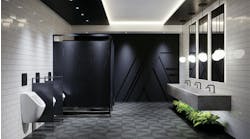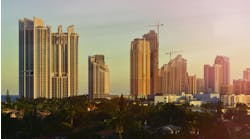Metal roof systems are available for virtually every structure and design. In centuries past, before the Industrial Revolution, soft, malleable metals (such as lead) that could be installed using skilled labor and hand tools were used. With the availability of steel and aluminum, along with mechanized forming and application equipment, metal became cost-effective for both non-structural and structural applications.
Evolution of Protective Coatings for Steel
When metals are in contact, one metal (zinc) will give up electrons and oxidize while the current generated will prevent oxidation of the other metal (steel). This mechanism extends the structural life of products made from galvanized steel. A patent on zinc-coated steel (galvanize) dates back to 1837. In roofing, corrugated zinc-coated steel provides a utility type roof, generally used on small roof areas and overhangs with through-fastening to structural supports.
Using an alloy of zinc and aluminum (Galvalume) greatly increased the durability over zinc coatings alone. For non-residential roofing, bare or unpainted Galvalume sheet is used for low slope, concealed fastener standing seam roofs (SSR) as a replacement for nonmetallic built-up rubber and ballasted nonmetallic roofs and for steeper slope screw-down roofs with exposed fasteners.
Prepainted Galvalume sheet is mostly used for steep slope architectural roofing and mansards to enhance the appearance of the building using color, form, and texture. Nonresidential roofs can be new or retrofit over both old steel and nonmetallic roofs.
Evolution of Today’s Metal Roof Systems
Beyond the increased durability of coated steel panels, a number of technological breakthroughs were necessary. While panel runs in residential construction were relatively short due to the rapid rise in elevation with building size, the runs could be several hundred feet long for commercial applications. If long runs were through-fastened, fasteners would shear or buckle, panels would warp, and fastener holes would become elongated. (Coefficients of thermal expansion are expressed in inches of movement per inch of length per degree of thermal change.) In modern systems, the roof panels are anchored at just one point, usually the eave, and allowed to move towards the ridge.
The utilization of two-piece floating clips accommodates this thermal movement, but at the same time anchors the panels against wind uplift. The base of the clip is anchored to the structural supports, while the upper piece is embedded in the panel seam and moves with the panels in response to thermal change.
Thermal spacers, usually made of compressive-resistant foams, eliminate short-circuits where fiberglass insulation is compressed over purlins. Sealants have also evolved and can be embedded in the female leg of the panel during roll-forming, hand-applied from premeasured and pre-cut self-adhering tapes, or hand-pumped with a caulking gun to complete a water-resistant panel system. When not exposed to the weather, butyl tapes are tenacious and extremely durable.
Roof Drainage
If the existing roof system drains poorly, new structural components can redirect the water flow to eave gutters. Since water cannot flow over raised seams, factory-fabricated curbs permit the seams to stop short of obstructions.
Reroofing and Re-Cover
Many of today’s inventories of roof systems have inadequate slope, thermal insulation, or both. Metal re-cover systems improve the slope and appearance of buildings, not only with existing metal roofs, but over existing bituminous and single-ply systems as well. In many cases, demolition of the existing roof is not necessary and the re-cover system meets building codes.
Steep roof conversions are feasible on buildings that are not excessively wide. Where increased slope is not needed but increased thermal performance is desired, new steel members can be through-fastened into the building’s structural system. The added elevation can be vented or filled with additional thermal insulation to meet the latest versions of building codes. The roof pitch can be changed so that the roof drains at eaves rather than internally.
Metal and Cool Roofs
While zinc and Galvalume finishes are very reflective, a cool roof needs both high reflectivity (albedo) and high emissivity. Bare metal surfaces have poor emissivity, but by applying polymeric films, emissivity approaches that of single-ply roof systems.
Since many owners and designers are not enthralled with metallic-appearing coatings or a white color, there was a need for improved reflectivity in earth tones, for example, because they reflect more of the near infrared. Reflective pigments in earth tones let the designer meet aesthetic goals while maintaining energy efficiency in the end result. Low VOC compliance is now possible with a generation of water-based polymers for coating or maintaining metal roof systems.
Metal Roofing and Photovoltaics
The concept of combining photovoltaic arrays with standing seam metal roofing is growing – and for good reasons. A standing seam metal roof has a life expectancy consistent with that of framed PV modules. A 30-year power source on a 30-year roof, along with zero penetration technology, creates a sustainable roof system without compromising the roof's warranty and water-tightness. To learn more, visit www.roofingcenter.org.
For more information, check out the Metal Building Manufacturers Association, which offers a variety of educational material at www.mbma.com.
Richard (Dick) L. Fricklas was technical director emeritus of the Roofing Industry Educational Institute prior to his retirement. He is co-author of The Manual of Low Slope Roofing Systems and continues to participate in seminars for the University of Wisconsin and RCI Inc. - The Institute of Roofing, Waterproofing, and Building Envelope Professionals. His honors include the William C. Cullen Award and Walter C. Voss Award from ASTM, the J. A. Piper Award from NRCA, and the James Q. McCawley Award from the MRCA. Dick holds honorary memberships in both ASTM and RCI Inc.
Quick Fixes for Metal Roof Systems
Repair the most common types of damage to metal roofing systems.
Coping with Rooftop Penetrations through Standing-Seam Metal Roofs
Follow these guidelines when mounting essential rooftop equipment and mechanicals on a metal rooftop.
Metal Roofing - A Cool Choice for Any Building
Reduce cooling and heating energy usage with cool metal roofing systems.


